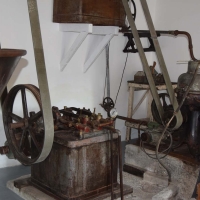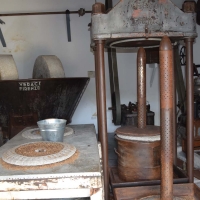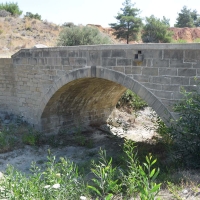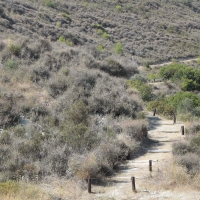Food & Relaxation
Τα Πιατάκια Της Ασγάτας
Πλατεία του χωριού
Τηλ: 96140442









Mines
The mines of Asgata were renamed and remained known as the “mines of Kalavasos”.
It appears that the mines had been in operation ever since the ancient times and more specifically since the Copper time, and this continued later on during the Roman Times. This is proven by the findings in the area which include ancient tunnels, sloping wells and huge piles and rust. The rust constitutes the remains of processing chalcopyrite in a kiln, which was apparently done on site. Timber from the forests that probably existed in the area of the mines was used to fire the kiln.
Extracted from our mines were chalcopyrite, iron pyrite and small quantities of gold. In the ancient times the mines were identified by observing the oxidized rocks above the mineral deposits and next tunnels or sloping wells were dug in order to reach the mineral deposits.
For unknown reasons the mines remained closed for several years and reopened during the first decades of the 20th century. In 1925 the British firm “Rio Tinto Copper Mines” began researching and in 1928 it started extracting from the mine. In 1934 the company sold its privilege and operations to the “Anonymous Greek Chemical Products and Fertilizers Company”, which was later renamed to EME and belonged to Greek businessman Prodromos Athanasiades-Mpodosakis. In 1933 Mpodosakis hired and brought to Cyprus a young mine engineer named Costas Magklis, who was assigned with the task of managing the mines of Asgata-Kalavasos, which started operating at the beginning of 1935.
The mines gave Asgata a new lease of life and in the years to follows the village experienced such a growth which resulted in doubling its population. During the years 1937-1967, which was the peak period for the mines, at the village there were two tailor shops, seven shoe making shops, three blacksmiths, three barber shops, five grocery stores, two taverns, a professional bakery, two olive mills, a flour mill and five coffee shops. Moreover, the housing of “Plateion” was built in 1937 just outside the village, in the area of the mines. At the housing resided the manager of the mines, the Greek foremen and a lot of workers from all over Cyprus. In fact, all these people and their families participated in the social and financial life of Asgata.
Five mines operated in our area from 1936 until 1978, covering a land expanse of 17 square kilometres, the centre of which was located northeast of the village. The mineral from all five mines was transferred with lorries to the central mine platform, which was situated above the “Kanellopoulos Tunnel”, next to the river bed of Vasilopotamos and from there on it was transferred by rail, via Kalavasos, to Vasiliko, where it was processed. Next, using an overhead loading system, it would end up in the cargo hold of ships so that it would be exported. The first loading on a ship took place in April 1937. The total volume of the deposit reserves in the area of Asgata, according to calculations by the manager of the mines at the time Mr Loukas Mousoulos (who later became an Academic and Professor of the National Technical University of Athens) amounted to 8.5 million tonnes. In total, approximately 5.5 million tonnes were extracted from the area.
The five mines are listed below:
Plateies Mine
Situated at a distance of 1 ½ km north of Asgata is the Plateies Mine, one of the most ancient mines of Cyprus, also known as the “Roman” mine. The large accumulation of rust and other mineral remains reveal the intense mining activity that took place during the ancient times. When the mine was excavated near its surface during the modern times, its walls revealed ancient tunnels and sloping layers. Salvaged in the area south of the mine, near the old bridge is the most recent tunnel which led to the ore deposits. This tunnel was known as Tunnel 247 and it had been named after the altitude above sea level at which the tunnel entrance was located.
The volume of the ore deposit of the Plateies Mine was approximately 250.000, while its copper and Sulphur content was 1% and 30% respectively. The most recent ore extraction began in 1955 and continued until 1965, while approximately 45.000 tonnes of ore were extracted.
Mavri Sykia Mine
This mine was known as “Tunnel 200”, which revealed the altitude of the tunnel entrance above sea level. It is located approximately 2 km northeast of Asgata and during the ancient times there was intense extraction in the area. The deposit volume was 1.5 million tonnes, with a mean content in Copper and Sulphur of 1% and 30% respectively. The deposit extraction began in 1954 and continued until 1976, with a short temporary interruption in 1961 due to tunnel flooding.
The surface exploitation at the Mavri Sykia mine allowed EME to extract several quantities of gold.
Lantaria Mine
It is located very close to Mavri Sykia and the volume of the deposit was 500000 tonnes, with a mean Copper and Sulphur content being at 0.5% and 30% respectively. However, it appears that during the ancient times the exploitation of the deposit was limited. The most recent mining activity began in 1961 and ended in 1964, allowing the extraction of 440000 tonnes of mineral.
Mavridia Mine
It was the first mine where contemporary mining activity started in the area of Asgata. It is located at a distance of 1 ½ km east of Asgata and it is the largest in reserves and production of copper ores. It consists of seven deposits of a total volume of 5.750.000 tonnes. Of these, the largest one is deposit “B”, also known as the “Deposit of Mousoulos”, with a volume of 2.500.000 tonnes and a mean content in Copper and Sulphur at 2% and 40% respectively. This deposit was revealed in 1964, after it had been located by professor Loukas Mousoulos.
Mavridia had two main deposits, namely “A” and “B”, as well as five smaller ones. Deposit “A” had been exploited in the “copper and Roman times”. EME began mining in 1937 and temporarily interrupted extraction in 1939 due to a fire, before resuming mining again in 1954. Deposits “A” and “B” led to two large tunnels. In about 1970 began the surface mining of the deposits with stripping. These deposits were also accessed through the large 1 ½ km long “Nikolaou Kanellopoulou” tunnel, whose entrance is near the riverbed of river Vasilopotamos.
From the start of the mining activity at Mavridia in 1937 until the works were terminated in 1978 3.000.000 tonnes of ore were extracted.
Petra Mine
It is located 2 ½ km east of Asgata, near the border with Kalavasos. The volume of the deposit was 500.000 tonnes, with a Copper and Sulphur content of 1 ½ % and 40% respectively. The exploitation of the deposit began in 1953 and ended in 1966 with the total extraction reaching 300.000 tonnes of ore.
This mine must have undergone intense exploitation in the ancient times. This is evident by the huge rust piles in the area. Moreover, next to the tunnel that EME excavated in 1953, as well as towards the north there is an ancient sloping well, while near the riverbed there used to be a tunnel leading to this sloping well. This tunnel was used by the ancients as an aqueduct to pump water out. Both the sloping well and the tunnel were used by EME to provide staff access, as well as for ventilation and water pumping.
For about five decades, our mines offered employment to the rural population of Asgata and the neighboring communities, as well as to people from all over Cyprus, thus contributing to the prosperity of our community.
To get an idea of the atmosphere during the beginning of the mining works, we cite some extracts from reports which were sent and published in the monthly issue of the American Association of Asgata Residents in New York (even though the reports contain a lot of exaggeration, they are, up to a point, representative of what things were like).
The November 25th 1937 issue mentions the following: “Life in our village has changed so much for the better thanks to the mine. There are now five cars and nice roads. The mine has benefited our village enormously since everybody who wishes to can now be employed at the mine for 2 ½ schillings for eight hours of work per day. Several workers reside at the village and shop from our grocery stores. Moreover, the mine holds a first class market where local products are sold. Several fellow villagers sell whatever they have for sale, such as fruit, vegetables etc. directly to the workers at the mine or at the canteen. Thanks to the mine the roads have been repaired and bridges have been built at the locations of “Hartzin” and “Potami”. Currently, everybody is working intensively for the construction of the new village of Platies, an entire town with more than 2000 residents”. The March 1938, issue 27, mentions that “the mines are operating smoothly. The mountains of our village, from Platies to Mavridkia and Mea Potamon now resemble Detroit and Pittsburg in America because of the number of engines and factories”.
Source: Antonis Kavazis – “Asgata – History and Memories”





Μuseums
ASGATA OLIVE AND FLOUR MILL MUSEUM
The Asgata Olive and Flour Mill Museum building, which is located in the centre of the community, was originally used, in 1920, as a factory.
There are five halls which guests can visit.
Installed inside the largest hall of the museum is the olive mill with all the machineries and relevant equipment. Inside the engine room is the engine that powered all the machineries using gears and conveyor belts. The flourmill and the tools used during wheat grinding are displayed in a separated hall. Shown in the projection hall are two documentaries on olives and wheat, while at the reception hall one can see various pictures related to the museum and its former function as an olive and flour mill.
At the Museum there are also audio representations which explain how the engine of the olive and flour mill worked.
Free guided 30-minute-long tours are offered both to groups or individual visitors, during which the operation of the olive and flour mill are explained. Tours can also be offered outside working hours upon request which can be arranged over the phone.
Working Days and Hours
Sunday 11:00-17:00
Visits outside working hours upon request
Exhibitions are permanent
Entrance Fee












Old Bridge



Old Irrigation
In 1944-45 our fellow villagers worked voluntarily to build the irrigation system, while the Association in America and the state funded part of the project. The system’s starting point was at the river “Hartzi” and several small canals distributed the water around the village. More specifically, the system irrigated approximately 400 square kilometres during the months when the river was flowing.
Salvaged until today at the location “Hartzi” is the base of the system which used to direct the river water towards the canal. This was possibly done using a huge valve which would close and open the irrigation system’s door. Until today, that part of the river is called “timoni” (steering wheel).





Nature trails
In the area of Asgata there are beautiful nature trails and rural roads one could walk or cycle along and enjoy nature.
An interesting route along which nature lovers can walk is the route leading from “potamia” (rivers) to “Hartzi”. Along the way they will walk past “Kourvellorotsos”, the waterfall of the “Mersineri” creek, the “Kokkinorotsos” and the old bridge.
Another beautiful route starts just before the downhill road leading to Asgata, at the location “Stavri”. Visitors can either use a car or a bicycle or even walk the distance by heading towards “teratsotos”, where, after reaching the highest point, they can enjoy the view all the way from Zygi to Limassol before walking down towards the village, along the road leading to Kalavasos.
Starting from the same location in “Stavri”, one can head north, towards the rural road leading to Troullous and after passing by the reforested area along the mountain slope they can reach “Vathin Arkatzin” located along the road to Vasa. Also, they can continue their course towards the ridge from Troullous and reach the locations “Isiomata” and “Leivadi” on the border between Asgata and Vasa, where they will find a huge plantation with pomegranate trees.
Towards the south of the village, on the road leading to Kalavasos, an area was included in the Nature 2000 network. There is a trail leading to a location where a certain plant called Lefkara Milk Vetch is studied. This species was included in the network of plant micro reserves for the preservation of priority plants and habitats and is protected by the Verne convention.
Antonis Kavazis: “Asgata – History and Memories”
















